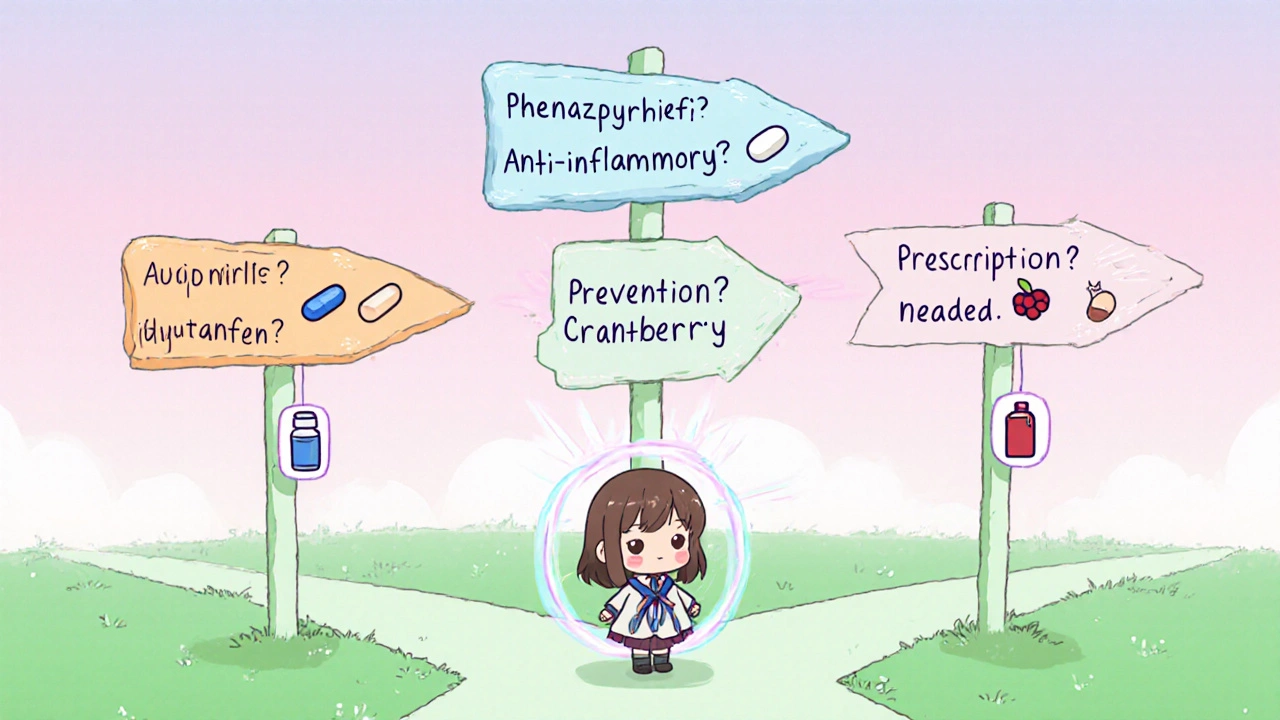UTI Symptom Relief Decision Tool
Personal Assessment
Your Recommendation
When a urinary tract infection (UTI) or bladder irritation strikes, the burning sensation can dominate the day. Over‑the‑counter relief is tempting, but not every product works the same way, and side‑effects differ. This guide walks you through Phenazopyridine alternatives, helping you decide whether Pyridium is right for you or if an NSAID, herbal supplement, or prescription option fits better.
What is Pyridium (Phenazopyridine)?
Phenazopyridine is a synthetic azo dye that acts as a urinary analgesic. It coats the lining of the urinary tract, dulling the pain signals that cause burning or urgency. Marketed under the brand name Pyridium, it is available in 100 mg tablets and 200 mg capsule form. The drug was first approved by the FDA in 1964 and remains the only over‑the‑counter medication specifically designed for urinary discomfort.
Typical dosing is 200 mg three times a day for no more than two days. Extending use beyond 48 hours can mask infection symptoms and increase the risk of side‑effects such as headache, nausea, and a vivid orange urine color.
How Phenazopyridine Works - Pros and Cons
- Mechanism: Directly anesthetizes the mucosal lining of the bladder and urethra.
- Onset: Relief often felt within 30‑60 minutes.
- Duration: Effects last about 4‑6 hours per dose.
- Pros: Fast, targeted pain relief without systemic anti‑inflammatory action.
- Cons: Does not treat the underlying infection, can cause orange urine that may alarm users, and is not recommended for pregnant women or patients with kidney disease.
Why Look for Alternatives?
Because phenazopyridine only masks symptoms, many clinicians recommend pairing it with antibiotics that eradicate the bacteria. If you prefer to avoid dye‑based drugs, have a history of liver or kidney issues, or need broader pain control, alternatives become attractive. Below is a quick snapshot of the most common options.
NSAIDs - Ibuprofen and Naproxen
Non‑steroidal anti‑inflammatory drugs (NSAIDs) reduce inflammation throughout the body, including the bladder wall. They are not urine‑specific but can lessen the burning sensation by tackling the inflammatory cascade.
- Ibuprofen (Advil, Motrin): 200‑400 mg every 6‑8 hours, max 1,200 mg OTC. Onset 30‑60 minutes, duration 4‑6 hours. Common side‑effects: stomach upset, increased bleeding risk.
- Naproxen (Aleve): 220‑440 mg every 8‑12 hours, max 660 mg OTC. Onset 45‑90 minutes, duration up to 8 hours. Side‑effects similar to ibuprofen but with a longer half‑life.
Both are OTC in most countries, but they should be taken with food and avoided in patients with ulcers, uncontrolled hypertension, or chronic kidney disease.
Acetaminophen (Paracetamol)
Acetaminophen works centrally to lower the perception of pain without anti‑inflammatory action. It’s a gentler option for those who can’t tolerate NSAIDs.
- Typical dose: 500‑1,000 mg every 4‑6 hours, max 3,000 mg OTC (4,000 mg prescription).
- Onset: 30‑45 minutes; duration: 4‑6 hours.
- Side‑effects: Rare at therapeutic doses, but hepatotoxicity is a concern if overdosed.
Acetaminophen is safe for most adults, including pregnant women, but liver‑sick patients should limit use.

Herbal & Dietary Options
While not as fast‑acting as pharmaceuticals, several natural products have evidence for easing urinary discomfort.
- Cranberry extract: Contains proanthocyanidins that prevent bacteria from adhering to bladder walls. Usually taken as 300 mg standardized extract daily. Best for prevention rather than acute pain.
- Probiotics (Lactobacillus spp.): Restore healthy vaginal and urinary flora, reducing recurrent infections. A typical dose is 1‑2 billion CFU per day.
- Uva‑Ursi (bearberry leaf): Historically used for cystitis. Limited modern trials suggest modest benefit; stay within 300 mg of dried leaf extract.
These alternatives are generally well‑tolerated, but quality varies. Choose products with third‑party testing.
Prescription‑Level Alternatives
For severe or recurrent cases, doctors may prescribe drugs that actually attack the infection or alter urine chemistry.
- Methenamine (Urotrol): Converts to formaldehyde in acidic urine, acting as a mild antiseptic. Dose 1 gram three times daily. Not suitable for patients with renal insufficiency.
- Phenazopyridine‑combined formulations: Some prescriptions add a low‑dose NSAID to a phenazopyridine tablet, giving both local anesthesia and systemic anti‑inflammation.
These require a physician’s order and regular monitoring.
Comparison Table
| Attribute | Phenazopyridine (Pyridium) | Ibuprofen | Acetaminophen | Cranberry Extract | Methenamine |
|---|---|---|---|---|---|
| Primary Action | Local urinary analgesic | Systemic anti‑inflammatory | Central analgesic | Anti‑adhesion, preventive | Urine antiseptic |
| Onset | 30‑60 min | 30‑60 min | 30‑45 min | Hours to days | 1‑2 hrs |
| Duration | 4‑6 hrs | 4‑6 hrs | 4‑6 hrs | Continuous with dosing | 6‑8 hrs |
| Typical OTC Dose | 200 mg q6‑8 hrs (max 2 days) | 200‑400 mg q6‑8 hrs (max 1,200 mg) | 500‑1,000 mg q4‑6 hrs (max 3,000 mg) | 300 mg standardized daily | Prescription only |
| Main Side‑effects | Orange urine, headache, GI upset | Stomach irritation, bleeding risk | Liver toxicity if overdosed | Rare, possible GI upset | Formaldehyde irritation, renal issues |
| Best For | Rapid relief of burning during UTI | General urinary pain with inflammation | Mild pain, patients avoiding NSAIDs | Prevention of recurrent infections | Chronic infections needing antiseptic urine |
How to Choose the Right Option
Think of the decision as a simple flowchart:
- Do you have a confirmed infection? If no, preventive options like cranberry extract are a safe start.
- Is rapid pain relief your priority? Phenazopyridine or an NSAID will work fastest.
- Are you pregnant or have liver/kidney disease? Skip phenazopyridine and NSAIDs; acetaminophen or herbal choices are safer.
- Do you need a prescription? Chronic or complicated UTIs may need methenamine or a doctor‑prescribed combination.
Always pair symptom‑relief drugs with an antibiotic regimen when a bacterial infection is present. Otherwise you risk masking symptoms while the infection worsens.

Safety Tips & Drug Interactions
- Phenazopyridine can interact with MAO inhibitors, raising the risk of hypertension.
- Ibuprofen reduces the effectiveness of certain antihypertensive meds (e.g., ACE inhibitors).
- Acetaminophen should not be combined with other hepatotoxic agents like certain antifungals.
- Herbal supplements may affect warfarin levels; check with a pharmacist.
If you’re on multiple prescriptions, a quick medication review can prevent surprise side‑effects.
Beyond Medication: Lifestyle Hacks
Medication eases pain, but lifestyle tweaks can speed recovery.
- Hydration: Aim for 2‑3 liters of water daily to flush bacteria.
- Warm compress: Applying a warm pad to the lower abdomen can relax the bladder wall.
- Urinate after intercourse: Reduces bacterial transfer.
- Avoid irritants: Caffeine, alcohol, spicy foods can worsen urgency.
Couple these habits with the right analgesic, and you’ll feel better faster.
Frequently Asked Questions
Can I take Phenazopyridine and an NSAID together?
Yes, you can combine them for added pain relief, but keep the NSAID dose low and take it with food to protect your stomach.
Why does my urine turn orange after taking Pyridium?
Phenazopyridine is a dye, and the unchanged portion is excreted, giving urine a bright orange hue. It’s harmless and fades after the drug clears your system.
Is Phenazopyridine safe for children?
The product is labeled for adults only. Pediatric use requires a doctor’s prescription and careful dosing.
How long can I stay on Phenazopyridine?
No more than two consecutive days. Longer use can hide infection signs and increase side‑effects.
Can I use cranberry supplements instead of medication?
Cranberry helps prevent bacteria from sticking to bladder walls but won’t relieve acute burning. It’s best as a preventive measure alongside antibiotics.
Next Steps
If you’ve identified the right option, grab the product from a reputable pharmacy or talk to your GP for a prescription if needed. Keep a symptom diary - note when pain starts, what you took, and how long relief lasted. That record helps your doctor adjust treatment if the infection returns.
Remember, relieving the sting is only half the battle; eradicating the underlying cause is what prevents future episodes.


Jay Kay
October 19, 2025 AT 16:43Phenazopyridine is just a flashy orange mask for your pain, not a cure. You think the burning disappears and the infection stays hidden. That's a rookie move, trust me. Stop relying on a dye and get proper treatment.
Sarah Unrath
October 19, 2025 AT 17:00i cant believe ppl still use that orange stuff its like drinking paint
Penny Reeves
October 19, 2025 AT 17:17In the hierarchy of analgesic pharmacodynamics, phenazopyridine occupies a niche of superficial uro‑mucosal desensitization, rendering it subordinate to agents with systemic anti‑inflammatory properties. Consequently, its utility is circumscribed to transient discomfort rather than comprehensive therapeutic resolution.
Ankitpgujjar Poswal
October 19, 2025 AT 17:50Listen up, you’ve got the power to pick the right tool for the job-don’t settle for just any over‑the‑counter fix. Pair the fast‑acting phenazopyridine with an antibiotic, and you’ll knock that infection out cold. If your kidneys or liver are on edge, switch to acetaminophen or a vetted herbal regimen. Push yourself to stay informed and stay healthy.
Bobby Marie
October 19, 2025 AT 18:07Seriously, just hydrate like a champ and ditch the caffeine. Your bladder will thank you.
Christian Georg
October 19, 2025 AT 18:40Hey folks 😊, if you’re juggling pain relief and infection control, start with a short course of phenazopyridine for immediate comfort, then follow up with the prescribed antibiotics. Keep a diary of what you took and how long the relief lasted-that info is gold for your doctor. And remember, staying well‑hydrated speeds up the healing process.
Monika Bozkurt
October 19, 2025 AT 19:13The deliberation over phenazopyridine versus its analogues encapsulates a broader epistemological discourse on symptomatic versus etiological interventions.
Within the clinical ontology of urinary tract pathophysiology, analgesic agents such as phenazopyridine serve as palliative adjuncts pending definitive antimicrobial eradication.
Conversely, non‑steroidal anti‑inflammatory drugs embody a systemic anti‑inflammatory modality that concurrently attenuates nociceptive transduction and inflammatory mediators.
Acetaminophen, operating via central cyclooxygenase inhibition, offers a hepatically safe alternative for patients contraindicated to cyclo‑oxygenase blockade.
Herbal derivatives, notably cranberry proanthocyanidins and Lactobacillus probiotic strains, contribute to uro‑protective prophylaxis through anti‑adhesive and microbiome‑modulating mechanisms.
Methenamine, a urinary antiseptic, exemplifies a pharmacodynamic strategy predicated upon in situ formaldehyde generation within acidic urine.
From a therapeutic algorithmic perspective, the clinician must weigh pharmacokinetic half‑life, tissue distribution, and patient‑specific comorbidities.
The patient’s hepatic and renal functional reserve dictate the tolerability thresholds for each pharmacological class.
Ethical stewardship mandates that symptom masking does not obfuscate infection surveillance, thereby averting iatrogenic complications.
Adhering to evidence‑based guidelines, a dual regimen of targeted antibiotics coupled with judicious analgesia optimizes clinical outcomes.
Furthermore, lifestyle modifications, such as augmented fluid intake and avoidance of mucosal irritants, synergize with pharmacotherapy to expedite convalescence.
In practice, shared decision‑making empowers patients to select agents aligned with their risk tolerance and quality‑of‑life considerations.
Optimism, when calibrated with scientific rigor, enhances adherence and fosters a positive therapeutic alliance.
Thus, the comparative matrix delineated herein serves as a pragmatic scaffold for individualized care planning.
May your clinical endeavors be guided by both empirical data and compassionate insight.
Christopher Burczyk
October 19, 2025 AT 19:30While the exposition admirably synthesizes the pharmacological landscape, it overlooks the pragmatic constraints of outpatient adherence, particularly the cost burden of third‑party validated herbal supplements. Moreover, the recommendation to employ methenamine without delineating its contraindications in patients with impaired renal clearance may engender clinical missteps. A more balanced discourse would integrate health‑economics alongside mechanistic detail.